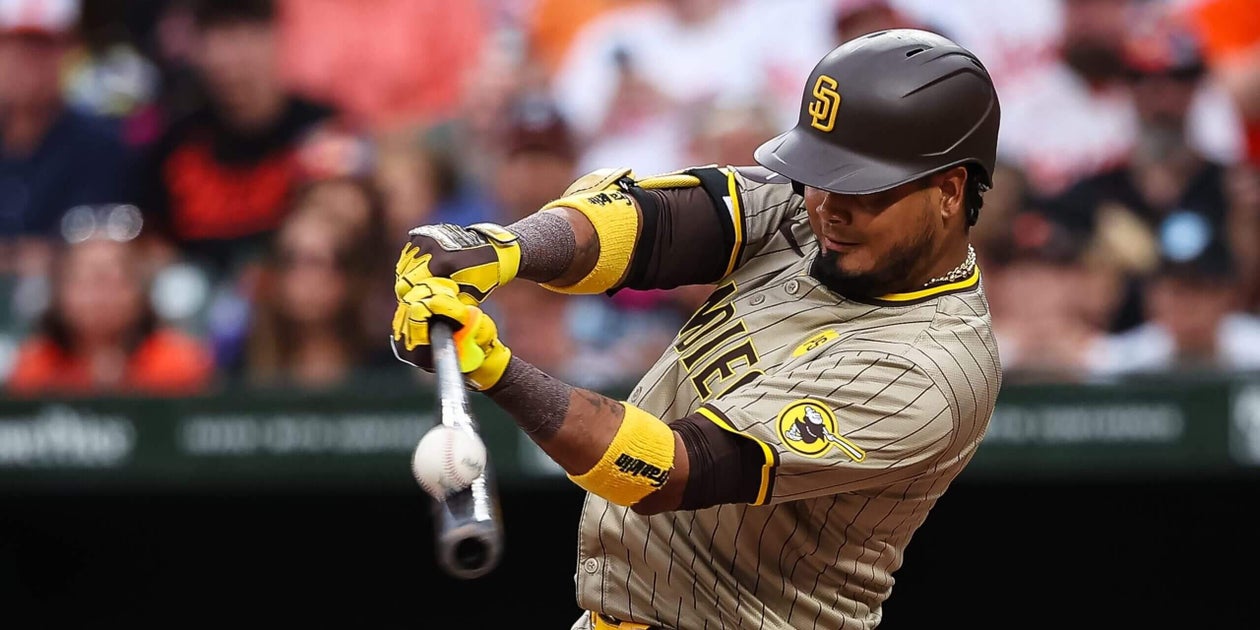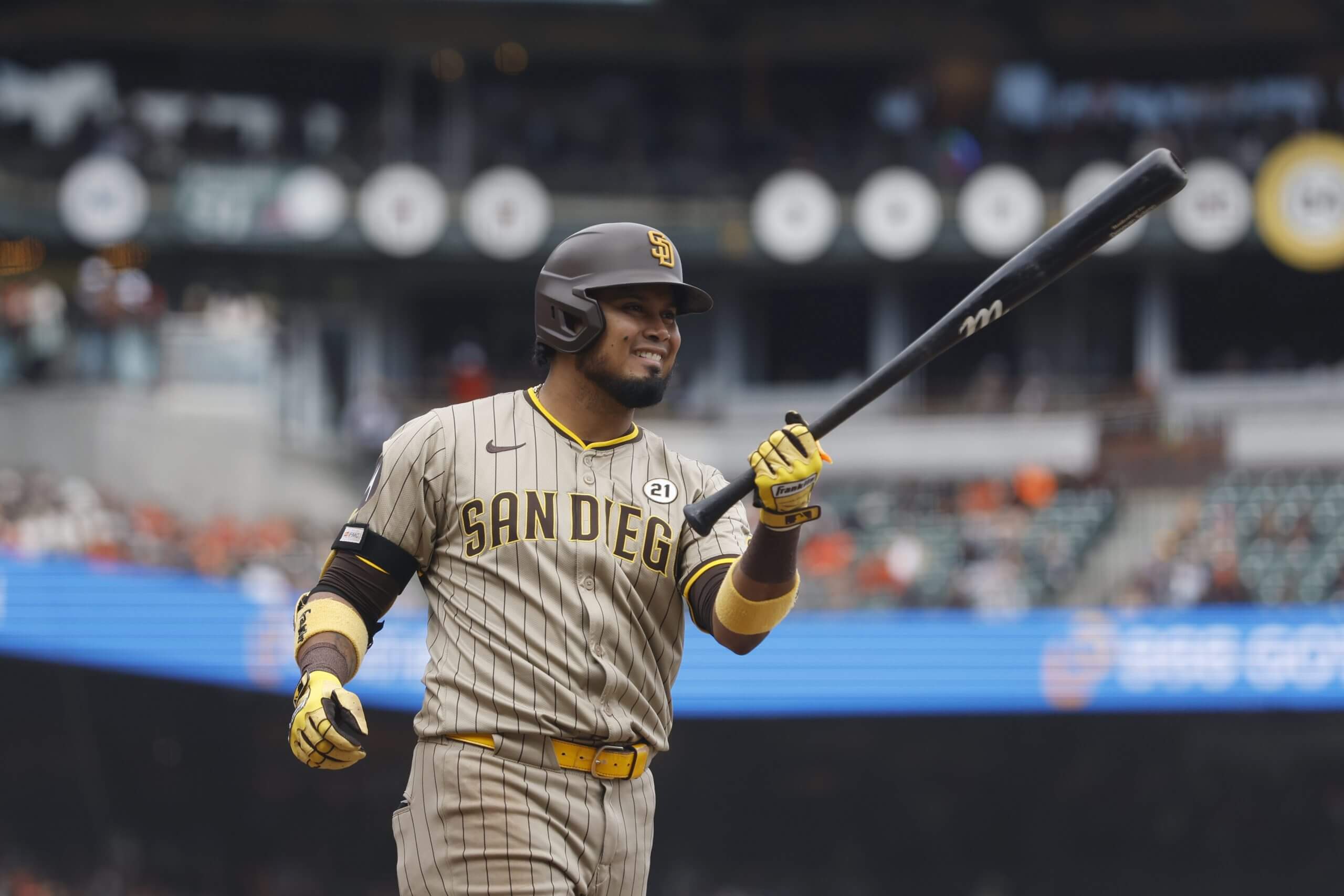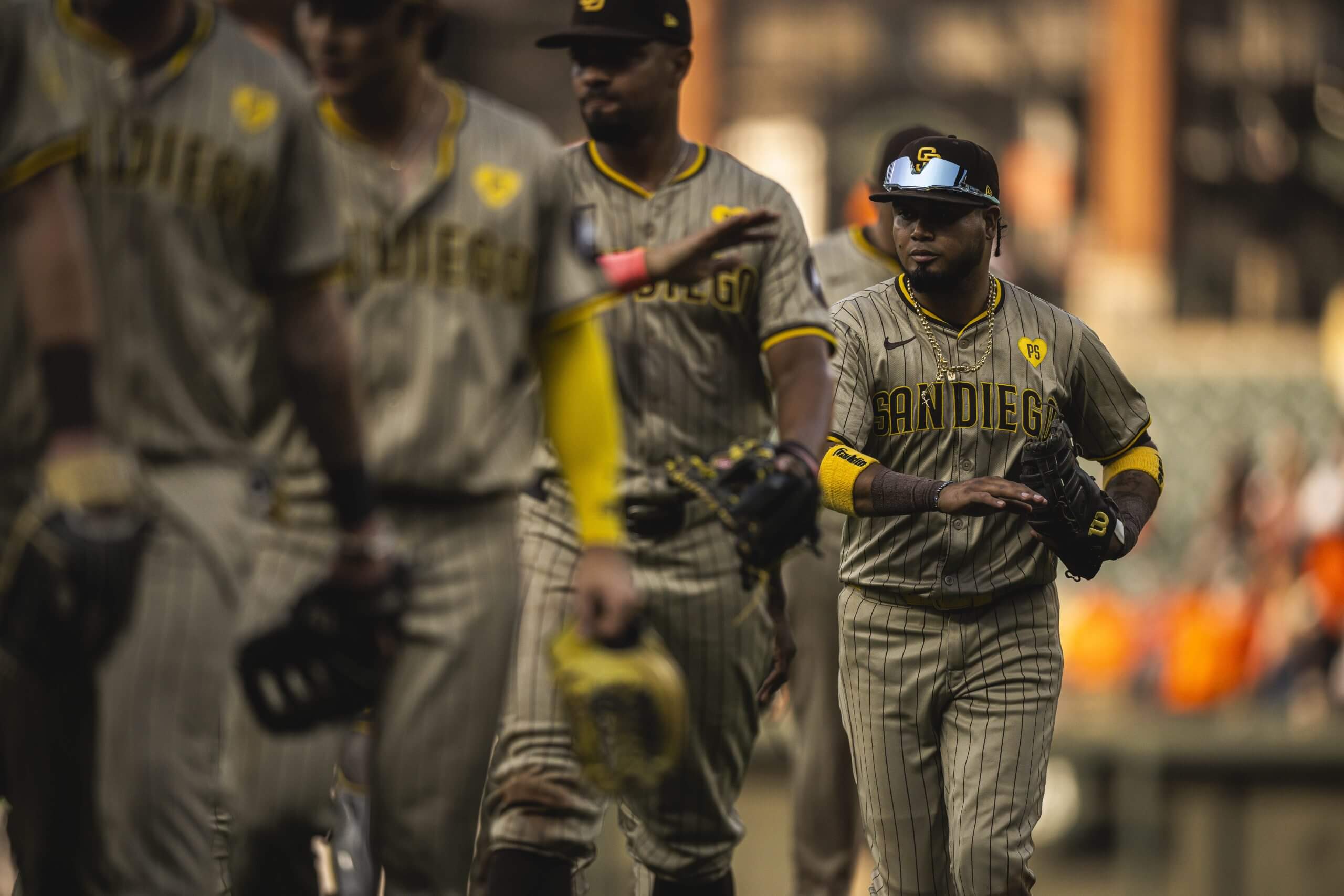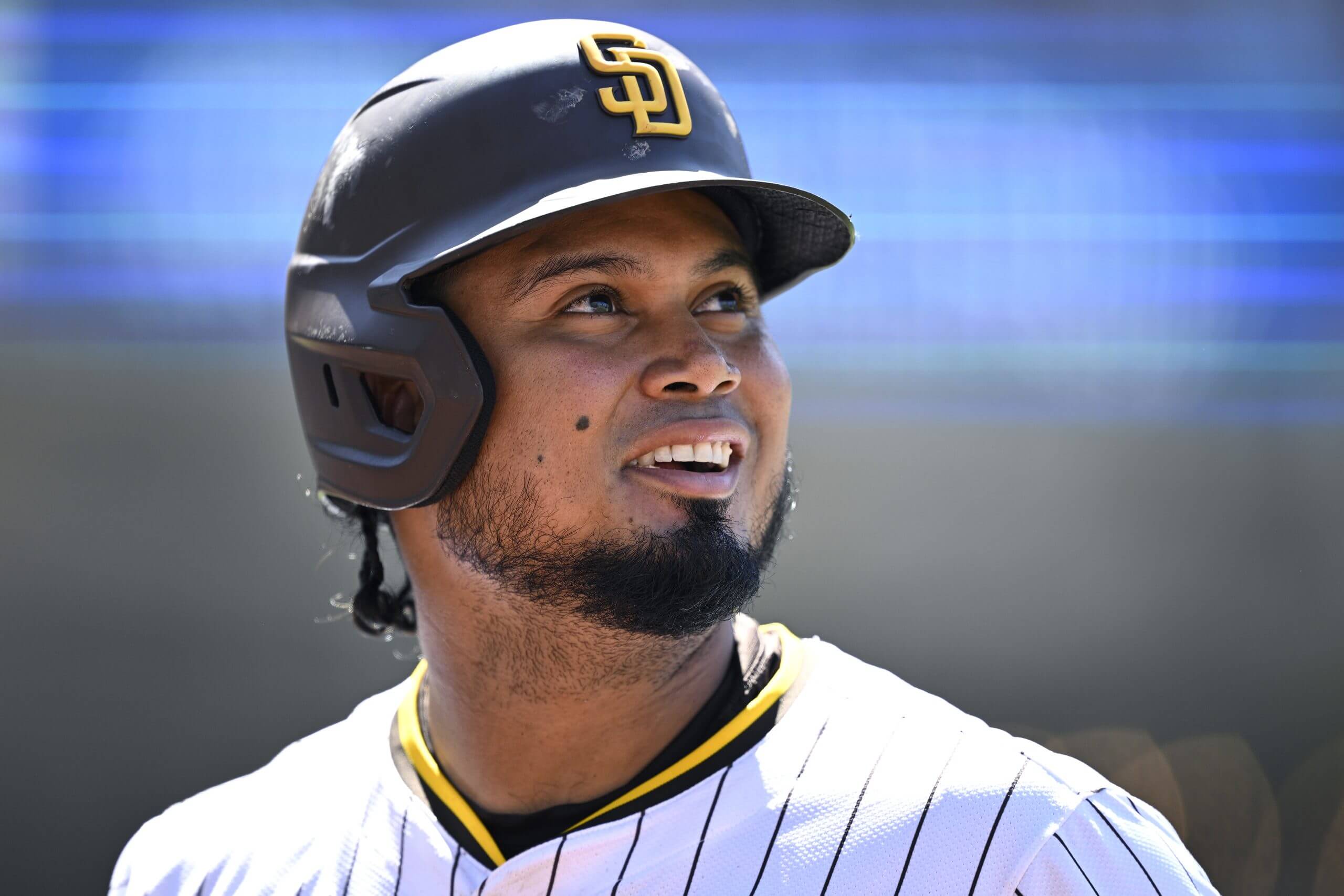
SAN DIEGO — When Luis Arraez leads off for the San Diego Padres in Tuesday’s postseason opener at Petco Park, he will do so as a three-time batting champion. He will also enter the left-handed batter’s box as a walking contradiction.
He has been traded twice in two years. He has lost a salary arbitration hearing. He has seen his impact downplayed by front offices and scores of baseball watchers who increasingly view the game through the lens of analytics.
And yet, in a lineup that features Manny Machado, Fernando Tatis Jr. and potential National League rookie of the year Jackson Merrill, Arraez is the face of an offense that fueled the Padres’ return to October. Around the sport, he might be known as a polarizing player. But inside the clubhouse walls in San Diego, there is little debate about his value.
“For a team like us, sky high,” left fielder Jurickson Profar said. “I can even say he transformed the lineup.”
By some measures, this regular season was the least productive in the career of a hitting savant. Arraez, who is approaching his final offseason before free agency, appears to be an obvious candidate for a contract extension. Yet, agreeing on his future compensation could be difficult. FanGraphs, the influential website that has turned fans into club employees, appraised his production in 2024 at a mere 1.1 wins above replacement. Among all qualifying position players, that ranked 110th.
But since he joined San Diego in a May 4 trade from the Miami Marlins, Arraez has batted first in every start. He has lit the way for perhaps the best — and arguably the most tenacious — offense in franchise history. Despite a torn ligament in his left thumb, he went 141 plate appearances without striking out. And since they acquired him, the Padres have played at a 97-win pace.
This, they believe, is no coincidence. Arraez established himself months ago as the catalyst of a contact-driven attack. And contact plays in October.
“With Arraez,” hitting coach Victor Rodriguez said, “he was perfect from the moment he got in.”

Luis Arraez, three-time batting champion. (Lachlan Cunningham / MLB Photos via Getty Images)
Designed to be all-encompassing, the metric known as wins above replacement has flooded the sport.
In the 2020s, the average difference between each league’s leader in Baseball-Reference WAR (rWAR) and its Most Valuable Player is smaller than in any prior decade. In 2021, Major League Baseball proposed replacing the salary arbitration system with a model reliant on FanGraphs’ version of WAR (fWAR). In clubhouses around the country, young players have grown up at least somewhat familiar with the doctrine of WAR.
“I see the numbers, but I don’t really know exactly what they mean,” Merrill said. “I’d say it makes sense when you look at (Aaron) Judge’s year and (Paul) Skenes and (Shohei) Ohtani and all of them. It makes sense why it’s so high compared to other players.”
Merrill and other Padres players, though, do not think that WAR accurately captures the value of Luis Arraez.
“For us, no,” Merrill said. “Because he doesn’t really just hit.”
Arraez, of course, specializes in a kind of hitting that has gone out of style. In 2022, when he led the American League with a .316 batting average, he was deemed a 2.7 fWAR player. That ranked 66th among qualifying big-league position players. Then Arraez spent the first half of 2023 flirting with .400. He settled at .354, the highest full-season average in the majors since 2010. His 3.3 fWAR ranked 54th.
This season, his shortcomings on defense and as a power threat appeared magnified. Arraez overcame a slow start with Miami and his lingering thumb injury to hit .314, withstanding a late charge from Shohei Ohtani to secure another National League batting title and become the first player to win three consecutive batting titles with three different teams. At the same time, Arraez recorded a .392 slugging percentage and a career-high 47 starts at designated hitter. His fWAR put him behind the likes of Maikel Garcia and Zack Gelof.
“We’re kind of, in terms of WAR, in a similar boat. We’ve both played first a lot … and DH for him, which are two, like, very offensive WAR positions,” said Padres infielder Jake Cronenworth, a two-time All-Star second baseman who logged 2.1 fWAR this season. “If you’re not hitting 30 homers a year, your WAR’s probably not going to be what it (should be).”
When asked for their personal appraisals of Arraez’s value, Cronenworth and others with the Padres tend toward superlatives.
“It starts off with one of the best hitters in the game,” Machado said. “Starting off the game like that is huge.”
“I know the singles hitter isn’t really valued as much in this game, but as a starting pitcher, it’s exhausting facing guys like that,” right-hander Joe Musgrove said. “Guys that don’t swing and miss, that don’t chase a lot, that are constantly on base — that wears you down over the course of an outing. It adds pitches to your outing. It makes you make more stressful pitches with guys on base. So, although it might not provide the instant runs that slug does, I feel like it’s extremely valuable.”
“Anytime you put the ball in play, anything can happen, so it’s very special,” infielder Xander Bogaerts said. “I think it’s a great fit for us. Obviously, he would be a great fit anywhere, but on our club, for sure.”

The Padres have bigger stars but Luis Arraez has been a catalyst. (Matt Thomas / San Diego Padres / Getty Images)
Three months before general manager A.J. Preller traded for Arraez, Rodriguez and manager Mike Shildt began stressing the benefits of “Petco Park hitting,” a line-drive, all-fields plan of attack that eschews deliberate attempts at generating home runs. The message has resonated, from the first day of spring training through Sunday’s regular-season finale at Chase Field.
Behind Arraez, the Padres finished 2024 at or near the top of the majors in such statistics as batting average, batting average with runners in scoring position, contact rate, strikeout rate, whiff rate, line-drive percentage and innings with four or more runs scored. A decade into Preller’s tenure, the Padres finally have an offensive identity that seems to produce results regardless of location. (Ironically, they wound up setting a Petco Park single-season record with 111 home runs in their home stadium.)
“We tried a lot of — you know, Petco Park, the ball doesn’t go anywhere,” said Profar, who has played for San Diego for parts of five seasons. “With the Petco Park approach that Victor brought, we do it during BP and stuff, we bring it to the game, and it really helps us.”
And no hitter embodies that approach as consistently as Arraez. Never mind that he hit .267 this season at Petco Park — he was relatively unlucky, with a .271 batting average on balls in play — and .342 everywhere else.
“Him and (Cleveland Guardians left fielder Steven) Kwan, guys like that, probably numbers-wise and analytics-wise, they are not high, but they make sense for a team that can hit, that has Profar, Machado, Bogaerts, all these guys,” Rodriguez said. “For them to score runs, somebody’s got to be on base. And he finds a way to be on base and create a good environment. Every time he’s hitting, we feel like he’s gonna do something good.”
“He’s been a huge part of this group,” Shildt said. “I don’t think there’s any coincidence. I think the record bears it out since we acquired Louie, what he’s meant to this club.”
2024 Padres, pre- and post-Arraez trade
| Period | BA | OBP | K% |
|---|---|---|---|
|
Pre-trade |
.252 |
.321 |
20.1% |
|
Post-trade |
.267 |
.325 |
17.0% |
One season with the Marlins was enough for Arraez, who already lived in Miami, to make it seem like he’d been starring there forever. Then a wave of pitching injuries and a 9-25 start prompted the front office to begin a teardown. Still, when Arraez was dealt in early May, the unusual timing of such a significant trade caught Marlins players by surprise.
Amid their sadness, they experienced something else.
“You’re happy for a guy that’s so good at getting base hits and being an energy, like, fountain,” said reliever Tanner Scott, who was reunited with Arraez at the trade deadline. “He brings so much energy to the table.”
The Padres have spent the past five months witnessing it for themselves.
There is the way Arraez, the league leader in singles, enthusiastically smacks the chest of first-base coach David Macias after each single.
“He’s a crazy motherf—,” joked Padres outfielder David Peralta. “I told him, ‘You need to stop doing that because you’re gonna stop his heart one day.’”
There is the way Arraez saunters around a clubhouse, involving everyone in conversation, and the way he greets every flight attendant when he boards a Padres charter.
“I’m taking him on any of my teams any year, any time, especially as a teammate and a friend,” Merrill said. “He’s unbelievable.”
There is the way Arraez hustles around the field, whether on a hit or after an out, and the way he bounds out of the dugout each night.
“He starts the game with a real high-level competitive drive that actually radiates,” Shildt said. “I mean, he literally jumps up the steps and jumps out and is ready to go take that first at-bat. … When you have somebody that comes up there right immediately and has that kind of energy and that competitive spirit, coupled with his bat-to-ball skills and his unbelievable talent, it just sets a great tone for us.”
Shildt, a former St. Louis Cardinals manager, said Arraez’s bat-to-ball skills are similar to those of retired catcher Yadier Molina. Shildt added that Arraez’s attentiveness during games, including from inside the dugout, reminds him of another Cardinals great, Albert Pujols.
“His energy, his passion, his dedication, his preparation are all very elite. They’re very elite,” Shildt said of Arraez. “And so, him being able to do that has only been able to bring others up around him. He’s rising our tide.”

“He’s rising our tide,” manager Mike Shildt said of Luis Arraez. (Orlando Ramirez / Getty Images)
Before he arrives at the ballpark, Arraez takes swings and performs drills almost daily with a short bat and a tee he takes with him on the road. He cannot remember the last time he skipped this routine ahead of a night game. “I think I need to start sleeping with my little bat,” Arraez said with a laugh. His combination of wizardry and diligence is such that he occasionally opts not to hit a single baseball before a game and “goes out and has four hits,” Cronenworth said.
Arraez does not gatekeep his obsessiveness. Teammates have found him to be a particularly insightful source of information. Minnesota Twins star shortstop Carlos Correa played one season with Arraez but still consults him for hitting tips. Cronenworth described Arraez’s ability to break down opposing pitchers as “second to none.” Speaking last week as the Padres neared a postseason berth, Rodriguez pointed out that Arraez’s ability to grind out hits against the game’s best arms could prove especially influential.
“If you as a player see his work and his dedication and how crazy about his craft he really is, you can see how he has done it,” Tatis said. “But it’s really amazing. I’m really proud of my teammate, of what he has overcome being traded two different times to different teams. It’s not fun at all, but he still finds a way how to go about his business every single day.”
Arraez, for his part, would not mind settling down after an itinerant few seasons.
“When A.J. brought me here, I felt like I was at home,” Arraez said inside the Padres’ clubhouse recently. “And let’s see, man. I can’t wait, I can’t wait. If he wants to sign me, I’ll be available to listen to him. If he wants to offer something, I don’t know, but I just want to stay focused on the playoffs.”
In this, his next-to-last season of arbitration, Arraez made $10.6 million (after seeking $12 million but losing to the Marlins in a hearing). The Marlins agreed to pay virtually that entire sum when they traded him, another sign of how the modern game has deprioritized contact hitting. The Padres, meanwhile, were happy to surrender a considerable amount of prospect capital to land a singular talent.
Soon, the feeling became mutual.
Never, Arraez said, had he heard a team discuss hitting the way these Padres do. Nor does he believe his former clubs appreciate contact and batting average as much as San Diego does.
“This team is special for me,” Arraez said. “It’s way different.
“A lot of teams, they just look for power hitters. They don’t look for hitters like me. But, hey, I don’t want to change anything. I just want to be me. I just want to bring the energy to this team. I think I did already, but I just want to continue doing it.”
This October, as the Padres pursue their first collective championship, Arraez will have an elevated stage to display both the measurable and the intangible aspects of his value.
(Top photo of Luis Arraez making contact: Scott Taetsch / Getty Images)